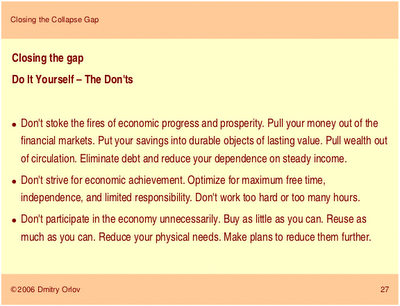
One of the advantages of moving back to
London this year has been the proximity and frequency of interesting events one could attend. In fact it can be overpowering at times and in fact lead to a profound inertia. Also it can be quite expensive, so it’s always good to find events that one is both interested in and which are free. All of which is a preamble to saying that after the Pugwash
event on Tuesday, I went to a
Gaia Foundation event last night – 2 things in 2 days!
The Gaia Foundation is another organisation which is new to me, but probably not to all of you as it has been working for over 20 years “to protect and enhance biological and cultural diversity”. Amongst its activities are regular Gaia Evenings with visiting speakers, which last night featured Dr Stephan Harding.

Dr Stephan Harding is the resident ecologist at
Schumacher College and the coordinator there of the MSc in Holistic Science. Earlier in the year he published the book
Animate Earth, which I greatly enjoyed – so it was a great pleasure to be able to slip up the road from Golders Green to Hampstead and hear him speak.

And what a speaker! He is extremely funny, a great communicator and carries the bearing of a man who really know his subject. He was also a wonderful palliative to the doom of the Pugwash event the day before. He did not avoid the darkside though and began his talk with a look at the “bad news” showing a large series of graphs indicating the enormous growth in various undesirable factors between 1750 and 2000. I tried to note all these down in some autistic flurry of fact gathering: population; damming of wild rivers; water usage; artificial fertilizer usage; decline in ocean ecosystems; loss of biodiversity; incursion of farmland into wild nature; paper usage; number of McDonalds “restaurants” (this one has really taken off since 1750); CO2 in the atmosphere; CH4 in the atmosphere; ozone depletion; motor vehicles…. That’s not all of them either. He continued the “bad news” section with the IPCC’s infamous hockey stick graph; a chart showing declines in the Living Planet Index between 1970 and 2000; and the News Economics Foundation’s national eco footprints (For the global population to reach UK levels of consumption would require 3.1 Earths, US levels 5.3 Earths).
All of this reflects a crisis in out world view, as we have effectively made “A War on Nature”, with destruction apparently an emergent property of our culture. The war analogy reminded me of part of Lovelock’s talk in which he compared the current global situation to the situation of the UK in 1940 awaiting the invasion of the enemy. Now, Lovelock said, we are at “war with the Earth”. Harding suggested that there were a number of points in time which we might focus on as the beginning of the crisis moment. In passing he mentioned the idea that the agricultural revolution could be that moment (the movement from the Palaeolithic to the Neolithic which Anti-Civ thinkers dwell on), but instead chose to talk about the 400 year old mistake kicked off by the scientific revolution.
Harding sees the mistake of the scientific revolution to be the privileging of the quantitative over the qualitative. He characterised this viewpoint with three quotes:
“Mathematics is the language with which God has written the universe.” – Galileo Galilei
“I have described the Earth and the whole visible Universe in the manner of a machine” – Rene Descartes
“[We must] endeavour to establish and extend the power and dominion of the human race itself over the universe” – Francis Bacon
Harding spoke of how this reduction of what is real down to mathematics, the mechanistic, and the quantitative - denied the value of appearance, of feelings. The scientific method demanded that qualitative reactions be ignored, that in fact scientists – like biologists performing live dissections - were under pressure to overcome their revulsion to their actions in order to “join the tribe”. Harding views this schism to have produced a kind of global schizophrenia – the opposition of quantitative and qualitative; facts and values; culture and nature. In order to heal this schism, we need to reassess our relationship with nature and to expand our mechanistic world view.

In order to do this, Harding suggest we look back to an old idea from Western culture that of Anima Mundi or Psyche Cosmu. Harding sees the tradition of animism or pan-psychism that has continued in Western though through Leibniz, Spinoza and Alfred North Whitehead to offer an opportunity to bring a new sensibility to culture and science. Here the archetype of Gaia has an important role to play.
“Verily at the first Chaos came to be, but next wide-bosomed Gaia, the ever-sure foundations of all” Hesiod, Theogony
The re-emergence of Gaia as an archetypal image in western culture after thousands of years of exile through the scientific work of James Lovelock and Lynn Margulis – has provided a way of understanding the world which can re-associate ourselves with a healthy holistic view of life and the Earth.
Harding went on to present how the Gaia hypothesis turned over the conventional view of the relationship between Earth’s biota and its abiotic environment. He presented some of the science that demonstrates how life on the planet modifies the atmosphere and uses positive and negative feedback loops to keep a balance. However rather than sticking to a dry scientific presentation, he presented the material in the form of a story – applying characteristics to the elements. So Oxygen was the passionate Italian of the period table, Carbon the placid Swede, Calcium the entrepreneur – and in his story Carbon was a prince, Calcium a Princess and the chemical reaction that brought them together was officiated by priestly water, that allowed their previous bonds to be broken and a new union to occur. So in this story carbon was removed from the atmosphere and locked into chalk. The story was an action in practice of applying animistic principles to science – revealing its value in altering our perception of the world; of developing understanding; and as a pedagogical device.


Harding finished with what he believed was the challenge facing our culture, the move from the conventional viewpoint which made the biosphere beholden to the “economy”, to an ecological viewpoint which makes the economy beholden to the biosphere. All this was a pleasant change from the business as usual paradigm I sensed at the Pugwash event. On reflection I don't suppose any of the speakers at the Pugwash event could really believe that we could continue with our current globalised capitalist economics - but didn't they have a duty to make that explicit? I understand from conversation with Stephan Harding after that talk that Lovelock uses the term "sustainable retreat" in favour of "sustainable development" which he considers impossible. The other great factor of Harding's talk in comparison with the Pugwash event, was how it showed science could serve a more integrated purpose, its radicalism was its greatest feature.
In the questions period after the presentation there was conversation about the absolute importance of localisation and community building, and also about the kind of global economics/politics that could best effect useful change - this quickly got into a conversation about TEQs (tradeable energy quotas), cap and trade, contraction and convergence and I have to admit useful as these schemes may be I always see these as more "market" solutions - and I'm not sure the market can truly solve this mess.
All the global economic tinkering -that's the 'big' stuff, the 'little' stuff is what we need to be getting on with - building those local networks, those communities - so shop local, get to know your neighbours start particpating in the future you want.




















































